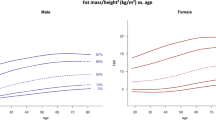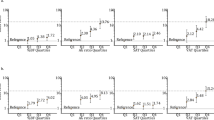Abstract
Introduction: Effective methods for assessing visceral fat are important to investigate the role of visceral fat for the increased health risks in obesity. Techniques for direct measurement of soft tissue composition such as CT or MRI are expensive, time-consuming or require a relatively high radiation dose. Simple anthropometric methods, such as waist-to-hip ratio, waist circumference or sagittal diameter are widely used. However, these methods cannot differentiate between visceral and subcutaneous fat and are less accurate. The aim of the present study is to investigate whether the dual-energy X-ray absorptiometry (DXA) method, possibly combined with anthropometry, offers a good alternative to CT for the prediction of visceral fat in the elderly.
Methods: Subjects were participants in the Health ABC-study, a cohort study of black and white men and women aged 70–79, investigating the effect of weight-related health conditions on disablement. Total body fat and trunk fat were measured by DXA using a Hologic QDR 1500. A 10 mm CT scan at the L4–L5 level was acquired to measure visceral fat and total abdominal fat. Weight, height, sagittal diameter and waist circumference were measured using standard methods. Fat in a manually defined DXA subregion (4 cm slice at the top of iliac crest) at the abdomen was calculated in a sub-group of participants (n=150; 50% male; 45.3% Afro-American/54.7% Caucasian, age 70–79 y). This subregion, the standard trunk region and total fat were used as indicators of visceral fat.
Results: Total abdominal fat by DXA (subregion) was strongly correlated with total abdominal fat by CT (r ranging from 0.87 in white men to 0.98 in black women). The DXA subregion underestimated total abdominal fat by 10% compared to the CT slice. The underestimation by DXA was seen especially in people with less abdominal fat. The association of visceral fat by CT with the DXA subregion (r=0.66, 0.78, 0.79 and 0.65 for white and black men and women, respectively) was comparable with the association of the CT measure with the sagittal diameter (r=0.74, 0.70, 0.84 and 0.68). Combining DXA measurements with anthropometry gave only limited improvement for the prediction of visceral fat by CT compared to univariate models (maximal increase of r2 4%).
Conclusion: DXA is a good alternative to CT for predicting total abdominal fat in an elderly population. For the prediction of visceral fat the sagittal diameter, which has a practical advantage compared to DXA, is just as effective.
This is a preview of subscription content, access via your institution
Access options
Subscribe to this journal
Receive 12 print issues and online access
$259.00 per year
only $21.58 per issue
Buy this article
- Purchase on Springer Link
- Instant access to full article PDF
Prices may be subject to local taxes which are calculated during checkout


Similar content being viewed by others
References
Vague J . The degree of masculine differentiation of obesities: a factor determining predisposition to diabetes, atherosclerosis, gout, and uric calculous disease. 1956 Nutrition 1999 15: 89–90 (discussion 91)
Fujioka S, Matsuzawa Y, Tokunaga K, Kawamoto T, Kobatake T, Keno Y, Kotani K, Yoshida S, Tarui S . Improvement of glucose and lipid metabolism associated with selective reduction of intra-abdominal visceral fat in premenopausal women with visceral fat obesity Int J Obes 1991 15: 853–859.
Leenen R, van der Kooy K, Droop A, Seidell JC, Deurenberg P, Weststrate JA, Hautvast JG . Visceral fat loss measured by magnetic resonance imaging in relation to changes in serum lipid levels of obese men and women Arterioscler Thromb 1993 13: 487–494.
Purnell JQ, Kahn SE, Albers JJ, Nevin DN, Brunzell JD, Schwartz RS . Effect of weight loss with reduction of intra-abdominal fat on lipid metabolism in older men J Clin Endocrinol Metab 2000 85: 977–982.
Van der Kooy K, Seidell JC . Techniques for the measurement of visceral fat: a practical guide Int J Obes Relat Metab Disord 1993 17: 187–196.
Plourde G . The role of radiologic methods in assessing body composition and related metabolic parameters Nutr Rev 1997 55: 289–296.
Mitsiopoulos N, Baumgartner RN, Heymsfield SB, Lyons W, Gallagher D, Ross R . Cadaver validation of skeletal muscle measurement by magnetic resonance imaging and computerized tomography J Appl Physiol 1998 85 (1): 115–122.
Abate N, Burns D, Peshock RM, Garg A, Grundy SM . Estimation of adipose tissue mass by magnetic resonance imaging: validation against dissection in human cadavers J Lipid Res 1994 35: 1490–1496.
Rossner S, Bo WJ, Hiltbrandt E, Hinson W, Karstaedt N, Santago P, Sobol WT, Crouse JR . Adipose tissue determinations in cadavers—a comparison between cross-sectional planimetry and computed tomography Int J Obes 1990 14: 893–902.
Zamboni M, Turcato E, Armellini F, Kahn HS, Zivelonghi A, Santana H, Bergamo-Andreis IA, Bosello O . Sagittal abdominal diameter as a practical predictor of visceral fat Int J Obes Relat Metab Disord 1998 22: 655–660.
Busetto L, Baggio MB, Zurlo F, Carraro R, Digito M, Enzi G . Assessment of abdominal fat distribution in obese patients: anthropometry versus computerized tomography Int J Obes Relat Metab Disord 1992 16: 731–736.
Ravaglia G, Forti P, Maioli F, Boschi F, Cicognani A, Gasbarrini G . Measurement of body fat in healthy elderly men: a comparison of methods J Gerontol A Biol Sci Med Sci 1999 54: M70–76.
Harris TB, Visser M, Everhart J, Cauley J, Tylavsky F, Fuerst T, Zamboni M, Taaffe D, Resnick HE, Scherzinger A, Nevitt M . Waist circumference and sagittal diameter reflect total body fat better than visceral fat in older men and women. The Health, Aging and Body Composition Study Ann NY Acad Sci 2000 904: 462–473.
Wang J, Thornton JC, Kolesnik S, Pierson RN . Anthropometry in body composition. An overview Ann NY Acad Sci 2000 904: 317–326.
Mazess RB, Barden HS, Bisek JP, Hanson J . Dual-energy X-ray absorptiometry for total-body and regional bone-mineral and soft-tissue composition Am J Clin Nutr 1990 51: 1106–1112.
Svendsen OL, Haarbo J, Hassager C, Christiansen C . Accuracy of measurements of body composition by dual-energy X-ray absorptiometry in vivo Am J Clin Nutr 1993 57: 605–608.
Jebb SA . Measurement of soft tissue composition by dual energy X-ray absorptiometry Br J Nutr 1997 77: 151–163.
Kamel EG, McNeill G, Han TS, Smith FW, Avenell A, Davidson L, Tothill P . Measurement of abdominal fat by magnetic resonance imaging, dual-energy X-ray absorptiometry and anthropometry in non-obese men and women Int J Obes Relat Metab Disord 1999 23: 686–692.
Clasey JL, Bouchard C, Teates CD, Riblett JE, Thorner MO, Hartman ML, Weltman A . The use of anthropometric and dual-energy X-ray absorptiometry (DXA) measures to estimate total abdominal and abdominal visceral fat in men and women Obes Res 1999 7: 256–264.
Kamel EG, McNeill G, Van Wjik MC . Usefulness of anthropometry and DXA in predicting intra-abdominal fat in obese men and women Obes Res 2000 8: 36–42.
Bertin E, Marcus C, Ruiz JC, Eschard JP, Leutenegger M . Measurement of visceral adipose tissue by DXA combined with anthropometry in obese humans Int J Obes Relat Metab Disord 2000 24: 263–270.
Jensen MD, Kanaley JA, Reed JE, Sheedy PF . Measurement of abdominal and visceral fat with computed tomography and dual-energy X-ray absorptiometry Am J Clin Nutr 1995 61: 274–278.
Seidell JC, Oosterlee A, Thijssen MA, Burema J, Deurenberg P, Hautvast JG, Ruijs JH . Assessment of intra-abdominal and subcutaneous abdominal fat: relation between anthropometry and computed tomography Am J Clin Nutr 1987 45: 7–13.
Chowdhury B, Sjostrom L, Alpsten M, Kostanty J, Kvist H, Lofgren R . A multicompartment body composition technique based on computerized tomography Int J Obes Relat Metab Disord 1994 18: 219–234.
Snyder WS, Cook MJ, Nasset ES, Karhausen LR, Parry Howells G, Tipton IH . Report of the Task Group on Reference Man. ICRP publication no. 23 Pergamon Press: Oxford 1975.
Bland JM, Altman DG . Statistical methods for assessing agreement between two methods of clinical measurement Lancet 1986 i: 307–310.
Tothill P, Hannan WJ, Wilkinson S . Comparisons between a pencil beam and two fan beam dual energy X-ray absorptiometers used for measuring total body bone and soft tissue Br J Radiol 2001 74: 166–176.
Prior BM, Cureton KJ, Modlesky CM, Evans EM, Sloniger MA, Saunders M, Lewis RD . In vivo validation of whole body composition estimates from dual-energy X-ray absorptiometry J Appl Physiol 1997 83: 623–630.
Martin AD, Daniel MZ, Drinkwater DT, Clarys JP . Adipose tissue density, estimated adipose lipid fraction and whole body adiposity in male cadavers Int J Obes Relat Metab Disord 1994 18: 79–83.
Wang J, Pierson RN Jr . Disparate hydration of adipose and lean tissue require a new model for body water distribution in man J Nutr 1976 106: 1687–1693.
Lean ME, Han TS, Morrison CE . Waist circumference as a measure for indicating need for weight management Br Med J 1995 311: 158–161.
Turcato E, Bosello O, Francesco VD, Harris TB, Zoico E, Bissoli L, Fracassi E, Zamboni M . Waist circumference and abdominal sagittal diameter as surrogates of body fat distribution in the elderly: their relation with cardio-vascular risk factors Int J Obes Relat Metab Disord 2000 24: 1005–1010.
Kahn HS, Austin H, Williamson DF, Arensberg D . Simple anthropometric indices associated with ischemic heart disease J Clin Epidemiol 1996 49: 1017–1024.
Pouliot MC, Despres JP, Lemieux S, Moorjani S, Bouchard C, Tremblay A, Nadeau A, Lupien PJ . Waist circumference and abdominal sagittal diameter: best simple anthropometric indexes of abdominal visceral adipose tissue accumulation and related cardiovascular risk in men and women Am J Cardiol 1994 73: 460–468.
Armellini F, Zamboni M, Harris T, Micciolo R, Bosello O . Sagittal diameter minus subcutaneous thickness. An easy-to-obtain parameter that improves visceral fat prediction Obes Res 1997 5: 315–320.
Visser M, Fuerst T, Lang T, Salamone L, Harris TB . Validity of fan-beam dual-energy X-ray absorptiometry for measuring fat-free mass and leg muscle mass. Health, Aging, and Body Composition Study—Dual-Energy X-ray Absorptiometry and Body Composition Working Group J Appl Physiol 1999 87: 1513–1520.
Salamone LM, Fuerst T, Visser M, Kern M, Lang T, Dockrell M, Cauley JA, Nevitt M, Tylavsky F, Lohman TG . Measurement of fat mass using DEXA: a validation study in elderly adults J Appl Physiol 2000 89: 345–352.
Svendsen OL, Hassager C, Bergmann I, Christiansen C . Measurement of abdominal and intra-abdominal fat in postmenopausal women by dual energy X-ray absorptiometry and anthropometry: comparison with computerized tomography Int J Obes Relat Metab Disord 1993 17: 45–51.
Acknowledgements
This study was supported by National Institute on Aging contract numbers NO1-AG-6-2101, NO1-AG-6-2103 and NO1-AG-6-2106, and by Hologic Inc.
Author information
Authors and Affiliations
Corresponding author
Rights and permissions
About this article
Cite this article
Snijder, M., Visser, M., Dekker, J. et al. The prediction of visceral fat by dual-energy X-ray absorptiometry in the elderly: a comparison with computed tomography and anthropometry. Int J Obes 26, 984–993 (2002). https://doi.org/10.1038/sj.ijo.0801968
Received:
Revised:
Accepted:
Published:
Issue Date:
DOI: https://doi.org/10.1038/sj.ijo.0801968
Keywords
This article is cited by
-
Identifying metabolic syndrome in migrant Asian Indian adults with anthropometric and visceral fat action points
Diabetology & Metabolic Syndrome (2022)
-
Obesity marker trajectories and cognitive impairment in older adults: a 10-year follow-up in Taichung community health study for elders
BMC Psychiatry (2022)
-
Higher erythrocyte n-3 polyunsaturated fatty acid were associated with a better profile of DXA-derived body fat and fat distribution in adults
International Journal of Obesity (2020)
-
Quantile-dependent heritability of computed tomography, dual-energy x-ray absorptiometry, anthropometric, and bioelectrical measures of adiposity
International Journal of Obesity (2020)
-
Dual-Energy X-Ray Absorptiometry Compared to Computed Tomography for Visceral Adiposity Assessment Among Gastrointestinal and Pancreatic Cancer Survivors
Scientific Reports (2019)



